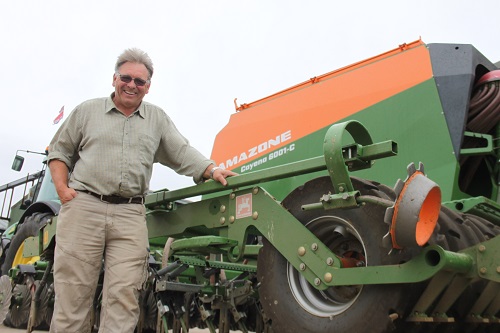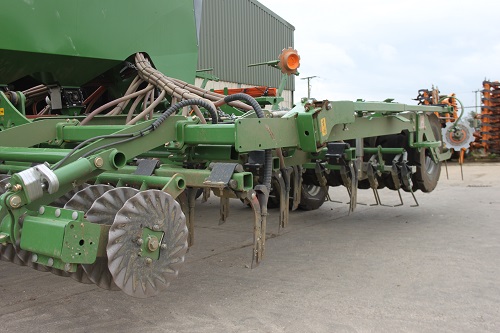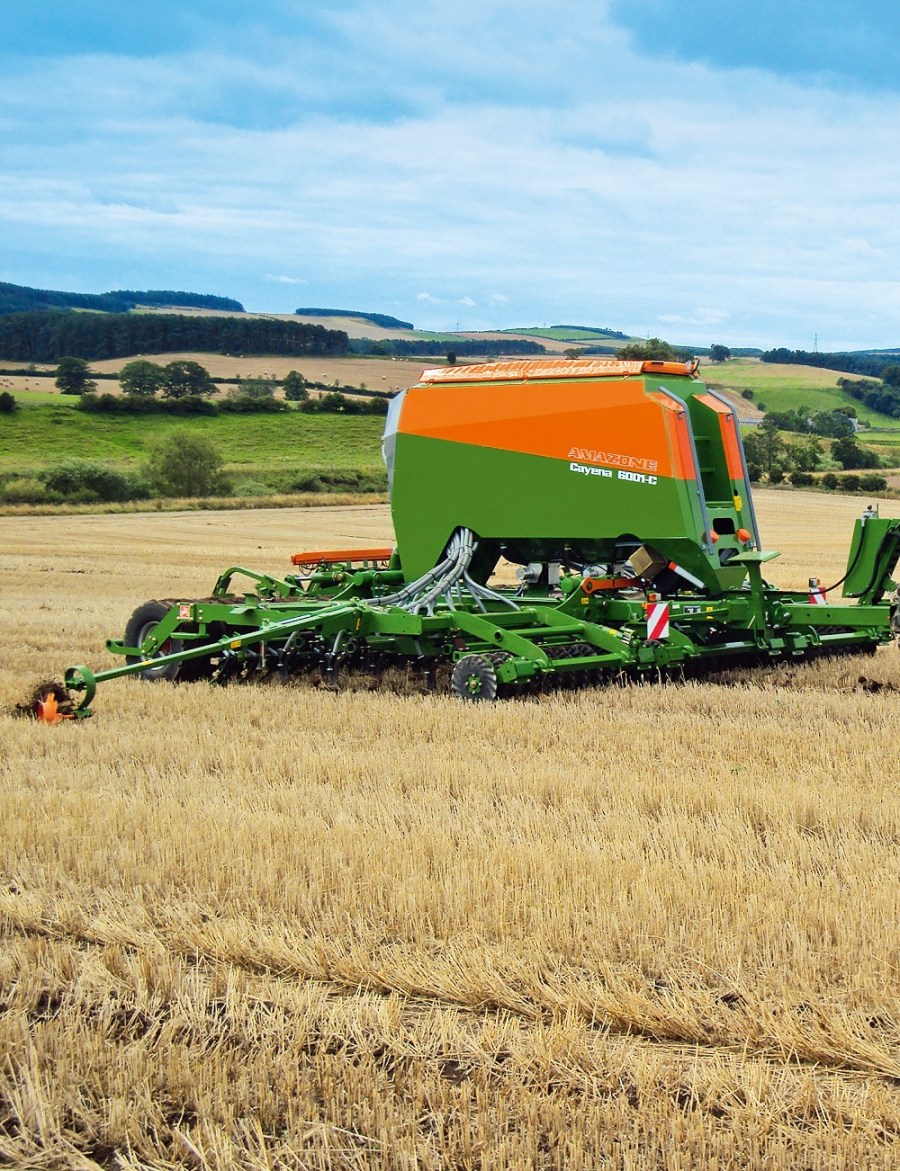Wanting to move away from cultivator drilling to minimise soil movement, but unconvinced a full shift to direct seeding would work on his heavy clay, one Cambs farmer has switched to Amazone’s Cayena disc opener/tine coulter drill. CPM visits to find out how it has performed.
I wanted to remove the cultivation element of drilling, but not necessarily go for a true direct drill.
By Martin Rickatson
In a ‘my soil’s tougher than yours’ competition, those working the heavy clays around south-west Cambs have got some sound bragging rights.
The ground on which Alan Rule farms varies a little, but not a lot – from clay loam at its kindest to heavy clay at its most challenging. Water and nutrient-retentive, it has the potential to produce high combinable crop yields, but if the weather isn’t favourable during establishment, they can become unworkable, whether very dry or very wet. And while cereals and oilseed rape don’t take kindly to such conditions, blackgrass thrives in them.

Alan Rule reasoned that a tine drill suited his strong clay land better than a disc type.
That’s why, back in the late 1990s, Alan moved from annual ploughing to rotational, and to min-till crop establishment using a cultivator drill. Over the interim, retaining weed seed either on the soil surface or burying it every few years has helped keep blackgrass largely in check. However, 16 years on, while an expanded contract farming area has helped spread costs and boost economies of scale, it has also created capacity and timeliness challenges. To counter this, there’s been a shift in drill type.
“When we moved to minimum tillage 20 years ago, we didn’t eliminate the plough altogether, but retained it as a reset measure that allowed us to bury weed seed in difficult fields when and where necessary,” he explains.
“More regularly we used a Cousins V-Form subsoiler to loosen compaction and a pigtail cultivator to create a surface tilth and weed chit. Complemented by the cultivation elements on the Väderstad Rapid drills we were using, this was sufficient to create a seedbed.
“It was a good system – I liked the seed placement, the drill coped well in most conditions, and we achieved some of our best-ever yields.
“But with a growing land area as we and Stephen Ayres, the neighbour we farm in partnership with, took on more contract land, taking our total beyond 1000ha, things began to change significantly. We needed more drilling capacity not just because of that expansion, but because over the past five years we’ve been only just keeping on top of blackgrass on our own land, achieving only 95% control, and facing some more difficult challenges with it on the contract ground.

A drill that closed its slot was among the chief requirements.
“We were front-loading with more autumn herbicides, and at best were holding our own and at worst starting to lose the battle, so needed to change strategy. While we’ve added spring barley to our rotation, I didn’t want to be forced into long-term spring cropping for more than a year at a time.”
Located close to Agrii’s blackgrass trials site at Stow Longa, Alan has followed with interest the work there and the advice stemming from it. One of the clearest pointers, he suggests, is the value of delayed drilling.
“It’s convinced us to push our wheat drilling start date back a month to the third week of Oct, but that obviously shortens the drilling window. And while we’ve recently been fortunate with dry autumns, the Rapid doesn’t like wet soils. So we began looking for a drill that moved the minimum of soil, benefiting us in both dry and damp conditions, and could also direct drill where we might want it to. In short, it needed to move less soil and be more versatile, offering the ability to, for example, drill beans successfully were we to replace OSR with more spring crop.
“I also wanted to move from 4m to 6m to gain more daily output, but ideally didn’t want that to require a bigger tractor. We do run two larger models than our John Deere 6210R drilling tractor, for ploughing, soil loosening and primary cultivations, but for drilling prefer a light, unballasted machine.
“So I wanted to remove the cultivation element of drilling, but not necessarily go for a true direct drill. I’ve seen different machines and their characteristics at Stow Longa, Groundswell and elsewhere, and one of the things of which I’m convinced is that a true direct drill cannot work consistently on land like this. However, I like the idea of a machine that can work directly if I feel the opportunity is there.”
Among the machines that came under consideration were disc drills including John Deere’s 750A, Great Plains’ Saxon and Sky’s Maxidrill. The key issue with all, though, was their ability to close the seed slot, says Alan.
“Even where they press the slots shut sideways, in dry autumns they can crack open, exposing the seed. We had some second wheat direct-drilled with a 750A, but found hairpinning of chopped straw into the slot could also be a problem.
“That led me to also consider tine coulter types. We looked at a Horsch Sprinter fitted with Dutch openers, but I felt we were going to struggle to pull a 6m with 200hp.”
It was after seeing it for the first time on the company’s stand at Cereals that Amazone’s Cayena came under consideration.
“I liked the single row of wavy discs that each cut a path for the tine coulters behind, and create a small amount of tilth, particularly for situations where we might try some direct drilling. The simple, narrow coulter design also appealed, and the way the 36 coulters are arranged over three rows, spaced well for good trash flow.
“I was initially wary of the tyre packer and how it would perform in damp soil, but reassured that the 6m Cayena weighs less than the 4m Väderstad. My only other concern was the drill’s more rigid design, and we’ve found it does work best on level land, whether cultivated or not.
“Two years ago, we booked a Cayena demonstration, using it to direct drill some OSR. It did a lovely job, and the crop emerged well. Based on its performance, I ordered a 6m Cayena-C, with a 4000-litre 60:40 split hopper allowing us to place some TSP at drilling where possible.
“Build quality is excellent, and has been mirrored by Amazone’s back-up. The only real issue we’ve had with the drill was a wheel hub failure on a Friday night. Amazone UK unfortunately couldn’t find one in the country, but arranged for a wheel, hub and bearings to be driven from Germany. They arrived late on Saturday, and by Sunday morning we were underway again. That sort of support can’t be faulted.”
Being on predominantly heavy land, some soil restructuring is necessary somewhere in most years, and on most ground the soil surface is shallow-cultivated at 50-75mm for a weed chit and creation of surface tilth for the crop. For these tasks the respective tools are a 3.5m Sumo Trio and a 4m Väderstad TopDown.
“Beginning as early as possible, we aim for at least one weed flush, and another if time allows. Another thing we’ve learned from Agrii’s Stow Longa work is that a six-week period between the last cultivation and drilling is optimal for best stale seedbed results.
“Over the past two years we’ve tried to ensure drilling’s complete by the end of Oct, although with hindsight kind weather up to Christmas meant we could have gone later. I’m sure we’re due a wet autumn though.”
The Cayena’s 800mm ribbed rubber press units that follow each coulter are liked for their ability to do a decent pressing job without picking up soil when damp, and in the right conditions Alan thinks he may cut back on rolling post-drilling.
“We run 12m rolls to cover the ground, but have to be mindful of capping on loamier soils in some conditions. In the dry they have their place, but in many circumstances I think we could now cut out their use, especially if damp. Where we trialled some direct drilling with the Cayena last year we found rolling wasn’t necessary, the angled covering tines following the coulters sweeping loose surface soil into the slots and the press wheels behind firming it in. I did specify following tine harrows, but often raise these as they have little effect. In dry conditions there have been notably fewer cracks in direct-drilled ground when compared with conventionally-moved.”
Alan’s system is now based on ploughing on a five-year rotation, with the TopDown or, where compaction needs to be addressed, the Trio used as the first pass in the interim years. Follow-up implements are a 6.6m Simba Cultipress or a 3m Simba Xpress if there’s a lot of straw to incorporate
“We’re still therefore using a fair number of cultivation processes, but they’re relatively cheap to run, and I think these passes are necessary on this land, primarily to keep grassweeds under control, but also address compaction and distribute organic matter.
“On the other hand, we haven’t been afraid to try working the Cayena directly. Spring barley land has been autumn lifted and pressed with the Trio, before a spring pass with our Simba Unipress and then the drill. This year we also replaced some OSR, which had been hammered by flea beetle, with late Oct direct-drilled wheat, the Cayena’s first real direct-drilling test. I didn’t want to pull up wet clay, so drilled direct into the sprayed-off OSR. The crop emerged well and it’s been an interesting experiment. For someone who isn’t a direct-drilling enthusiast, I’ve been impressed.”
It’s not just the wheats, but also the break crops that have been providing challenges of late. Traditionally the business’ rotation revolved around two wheats, winter barley and OSR, but over the past three years spring barley has replaced winter, largely due to margins.
“When barley prices fell to the £100/t mark the cost of winter barley – even hybrids producing 10t/ha – was so heavily front-loaded with herbicides and fungicides it was uneconomic to grow compared to spring-sown crops. We were grossing £1000-1100/ha at best. Switching to spring types has not only helped here, but also boosted blackgrass control, especially on the contract farms.
“With a new combine for this harvest we had the opportunity for the first time to yield-map fields. This was also the year our land was scanned and mapped by SOYL, and this autumn the plan is to begin using the drill’s variable rate capability to match soil type variation. A blanket seed rate can often prove too thick for the kinder, loamier areas, and we’ll probably look to raise rates from 400 seeds/m² to 450-500 on heavier areas, and on headlands, to improve their performance.
“We’ve not dropped the plough from our system, believing in the Agrii results from Stow Longa showing its value as a reset tool, with rotational ploughing proving its worth here too. I think the secret to keeping the home farm clean has been to not depend on one system and to keep mixing things. We use implements such as the plough, TopDown and Trio rotationally, and have been able to restrict delayed establishment to the more difficult fields.
“The two full years we’ve run the drill haven’t really given easy circumstances for comparison, especially with last year’s drought affecting growing crops through the summer and new crops established last autumn. That’s made yield gains challenging, but pre-harvest ear counts on wheat this year showed potential. In good conditions, the Cayena isn’t necessarily better than what we’ve had before, but it’s more versatile and adaptable, particularly when conditions get challenging.
“We don’t have wheel eradicators installed, but drop the coulters behind the tractor wheels in a little deeper to compensate for compaction. This year we’re looking to switch the tyres on the 6210R from the current Michelin MachXBibs, which can only operate down to 10psi (0.68 bar) to AxioBib VF types, which Michelin says we should be able to run down at 6-8psi (0.4-0.55 bar). That should further help to get crops off to a good start.”
Farm Facts
FB Rule and Son, Hilton, Cambs
- Farmed area: 1,000ha in partnership with Robert Ayres and Partners
- Soils: Loamy to heavy clay
- Staff: Alan Rule plus two
- Cropping: Winter wheat, spring barley, winter oilseed rape
- Mainline tractors: John Deere 8370R (hired for summer/autumn), 7920 and 6210R
- Combine: John Deere S780i (10.5m) and S680i (9m)
- Drill: Amazone Cayena 6001-C
- Sprayer: Househam AR5000 36m
- Fertiliser spreader: Amazone Z-AM 36m
- Cultivation equipment: 3.5m Sumo Trio, 4m Väderstad TopDown, 6.6m Simba Cultipress, 6.6m Simba Unipress, 3m Simba X-Press, Dowdeswell DP140 9f plough, 12m Cousins rolls




